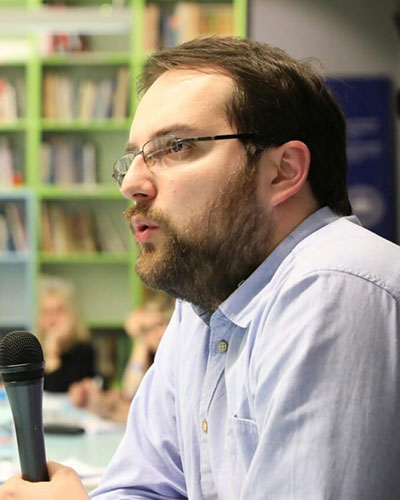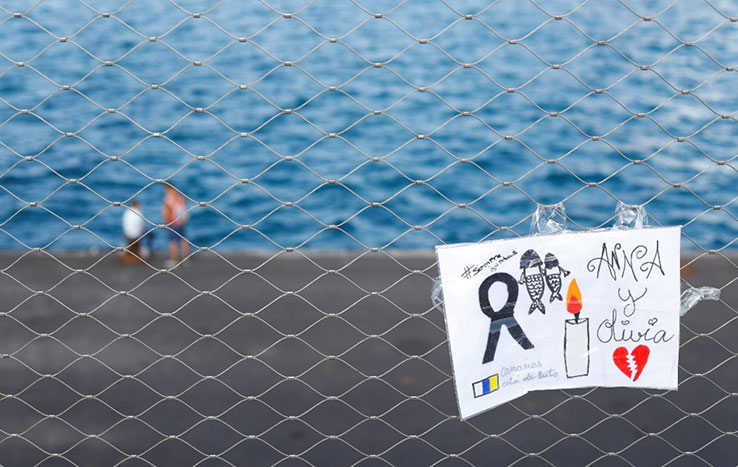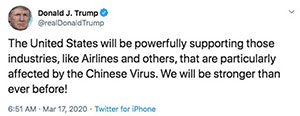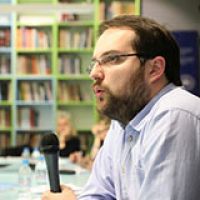Vuk Vučetić
 All conspiracy theories have very simple premises on which they rest. At the core of any conspiracy theory is the division of the world into good and evil. It is difficult to refute them because anyone who tries to do so is considered an accomplice to the conspiracy. The problem is that these theories spread very quickly, most often through social media, but also through closed groups on some platforms such as Viber and the like.
All conspiracy theories have very simple premises on which they rest. At the core of any conspiracy theory is the division of the world into good and evil. It is difficult to refute them because anyone who tries to do so is considered an accomplice to the conspiracy. The problem is that these theories spread very quickly, most often through social media, but also through closed groups on some platforms such as Viber and the like.
At a press conference following the inauguration of then-US President Donald Trump, White House Press Secretary Sean Spicer said, among other things, that it was the "largest audience to ever witness an inauguration in the history of the United States." Nearly all media quickly reacted. They found photos from previous inaugurations and realized that spokesman Spicer exaggerated in his assessment, to say the least, and that it was not the largest audience to ever witness an inauguration, but the contrary. Soon after, an NBC reporter confronted then-US presidential adviser Kellyanne Conway with this information, which she dismissed, explaining that Spicer had offered "alternative facts" about the inauguration. From that moment (January 2017), this term became an absolute "buzzword" and essentially opened a new socio-political chapter in the relationship to facts, truth, and reality in the broadest sense.
Alternative facts in the post-truth era
A new era in which alternative facts have replaced real evidence is called post-truth, where interpretations, emotions, beliefs have a stronger influence on decision-making than facts and evidence. Post-truth is an era in which the main socio-political actors try to convince the public to trust them, as their leaders, and not facts and evidence, which can be compared to a situation in which people are required to trust the person they are speaking to more than their own eyes. The concept of post-truth can be linked to what the famous American comedian and television presenter Stephen Colbert called the concept of "truthiness" more than ten years ago. Under the concept of "truthiness", he tried to explain, in a comical but also critical way, the danger of "people not thinking with their heads, but understanding with their hearts".
In other words, people accept and react positively to information because it provokes certain emotions and feelings, not because it is supported by real evidence. So, people’s feelings are in the foreground, as opposed to what is actually true. In this sense, it can be said that the post-truth era, announced by Colbert, is a kind of socio-political situation in which people tend to believe fake news, alternative facts and other forms of misinformation, because it can, for various reasons, give them pleasure and help them understand the reality in which they live.
The term alternative fact actually aims to explain that facts do not have universal meanings, but that their meaning is always related to context or that, depending on the context and point of view, facts can be interpreted differently or have different meanings. Therefore, as authors Turčilo and Buljubašić state, alternative facts can be defined as a form of manipulation, which is reflected in the selection, framing and contextualization of information in accordance with the interests of other actors, most often political. In that sense, alternative facts are actually facts "framed" in a certain context or presented only partially in order to create a déjà vu effect for the public and produce a certain reaction. Thus, alternative facts seem to create some, conditionally speaking, alternative reality with rules that are on the other side of rationality, factuality and truthfulness.
One way to define alternative facts is that they can refer to something that has the potential to be true, but does not have to be. This can include various information and claims that might be true i.e., there is a certain probability as well as certain evidence that they are true, but at the same time they do not have to be. More precisely, if the claim and its negation are equally justified i.e., there are equally valid reasons or equally strong evidence in support of either of these two possibilities, then such claims can be understood as alternative facts. In this context, various conspiracy theories can be observed for which there is no valid evidence, but which can be taken into consideration, provided that certain assumptions turn out to be correct.
Alternative facts as conspiracy theories amidst the coronavirus pandemic
All conspiracy theories have very simple premises on which they function. At the core of any conspiracy theory is the division of the world into good and evil. Then, each conspiracy theory is mainly characterized by the existence of a secret plan, which is carried out by some group. Also, there is always certain "evidence" that seeks to confirm the existing theory, which are usually accompanied by paranoid claims that everything happens for a reason and that there are no coincidences, or that nothing is as it should be and everything is connected. Once ingrained, conspiracy theories can spread rapidly. It is difficult to refute them because anyone who tries to do so is considered an accomplice to the conspiracy. The problem is that these theories spread very quickly, most often through social media, but also through closed groups on some platforms such as Viber and the like.
Conspiracy theories are not new. Some of the "most interesting" ones that are still on the agenda are related to events such as the September 11 terrorist attacks in New York, the assassination of US President John Kennedy, the landing on the Moon etc. All the important events seem to open the door to various conspiracy theories to find out what lies in the background. The coronavirus pandemic has also served as fertile ground for the development and spread of various conspiracy theories.
The most common theories were that the Chinese government made the coronavirus in a laboratory; that the pharmaceutical industry is involved in the spread of coronavirus; that there is a link between 5G technology and coronavirus; that the U.S. military developed the coronavirus as a biological weapon; that Bill Gates was using the coronavirus to "thread" a vaccine with a microchip that can keep track of people; as well as that the coronavirus "got away" from the laboratory in Wuhan.
 Source: rs.n1info.com
Source: rs.n1info.com
Like the virus itself, conspiracy theories survive and are transmitted through the host. Popular and influential hosts such as politicians and/or other celebrities can potentially infect millions of others with their activities. In that sense, former US President Donald Trump often used to call the coronavirus "the common flu" which will "disappear during the summer" etc. However, what puts him among those who spread the contagion of conspiracy theory is the tweet from March 2020, in which he called the coronavirus - the Chinese virus. This tweet supported theories that the Chinese were to blame for the formation of the coronavirus, and at the same time he started an avalanche of comments directed against the Chinese on social media.
In that sense, former US President Donald Trump often used to call the coronavirus "the common flu" which will "disappear during the summer" etc. However, what puts him among those who spread the contagion of conspiracy theory is the tweet from March 2020, in which he called the coronavirus - the Chinese virus. This tweet supported theories that the Chinese were to blame for the formation of the coronavirus, and at the same time he started an avalanche of comments directed against the Chinese on social media.
Much like Donald Trump were two U.S. senators who contributed to the spread of various theories about the coronavirus. Senator Rand Paul, a Republican from Kentucky, stated that he will not get vaccinated because he has previously recovered from corona. He also implied that natural immunity is more effective than a vaccine. Apart from politicians who thus contributed to the spread of various forms of conspiracy theories related to the coronavirus, this was also done by show business celebrities. One of the biggest icons of pop music in the US, Madonna posted a video on her Instagram commenting that the vaccine against corona has been around for some time, but it was deliberately kept from ordinary people so it would be easier to control them and for the rich to get richer.
Spreading conspiracy theories – domestic version
The Western Balkans were not immune to various forms of misinformation, fake news, alternative facts and conspiracy theories linked to the coronavirus. At the beginning of the pandemic, pulmonologist Branimir Nestorović assured the Serbian public that the corona virus is "the funniest flu", and that women could go on "shopping tours to Milan" without any worries. Given that the statements were made on February 26, 2020 i.e., at the very beginning of the spread of the coronavirus, it can be said that they were the result of insufficient information. The lack of seriousness and responsibility when publicly presenting information that directly concerns people's health is problematic and worrying. A similar “misstep" was made by Ivica Dačić, the then Minister of Foreign Affairs of Serbia, who stated on February 28, 2020 that it was not excluded that the coronavirus pandemic was "part of a special war against China".
Such statements can be categorized as unverified alternative facts, to say the least, and from a broader perspective they can be viewed as conspiracy theories. In addition, one of the prominent conspiracy theorists who received a lot of media space not only in shows on obscure Youtube channels but also on national TV stations in Serbia is clinical psychologist Mila Alečković. She is known for her theories that the pandemic is being used to introduce "experimental measures" aimed at "enslaving people" in order to enrich a small number of "globalists".
As in the West, apart from official politicians and relevant public figures, the problem of spreading various forms of misinformation and unverified information was exacerbated when popular entertainment and sports stars got involved. In that sense, the statement of folk singer Nada Topčagić is that you can cure corona with rakija and garlic, and the number one tennis player in the world, Novak Đoković, offered everyone his ten tips on how to fight the coronavirus. Croatian football player Dejan Lovren joined the wave of negative comments on social media directed against Bill Gates, who is considered to hold the most accountability for the emergence and spread of the coronavirus. Lovren wrote on his Instagram "Game over, Bill. People are not blind".
In that sense, the statement of folk singer Nada Topčagić is that you can cure corona with rakija and garlic, and the number one tennis player in the world, Novak Đoković, offered everyone his ten tips on how to fight the coronavirus. Croatian football player Dejan Lovren joined the wave of negative comments on social media directed against Bill Gates, who is considered to hold the most accountability for the emergence and spread of the coronavirus. Lovren wrote on his Instagram "Game over, Bill. People are not blind".
Social media are certainly one of the most effective platforms for spreading various forms of misinformation. In that context, in B&H, the group "Q-Anon Bosnia and Herzegovina" was active on Facebook for five months, and was then removed in October 2020. This group was part of the broader "Q-Anon" movement that was formed in 2017 in the United States and which followed the common motto #wwg1wga (Where We Go One, We Go All). The essence of this movement, which had its expansion on social platforms, is the spread of various forms of misinformation, fake news and conspiracy theories.
In that group, among others, one could find claims that: The coronavirus does not exist, but was invented; if it exists, it was created in a laboratory. Every parent is obliged to protect their child from mandatory vaccination. The introduction of 5G technology will bring irreparable consequences for all living things on Earth. In North Macedonia, it is increasingly popular to forward misinformation via direct messages, most likely on platforms such as Messenger, Viber, WhatsApp and the like. This is an effective way to spread misinformation as it is difficult to detect. It is also interesting that as effective methods o avoid detection of misinformation is sending screenshots, but also intentionally mixing Cyrillic and Latin alphabet in order to mask the trail.
However, in addition to these, conditionally speaking, isolated examples that can certainly illustrate certain trends, it is very important to point out the data from the research "Suspicious virus: Conspiracies and COVID-19 in the Balkans" conducted by the Public Policy Advisory Group: Balkans in Europe (BiEPAG) in 2020, on the popularity of various conspiracy theories in the Western Balkans. Research shows that nearly 80% of respondents believe, to a large extent or in part, in some of the conspiracy theories regarding the coronavirus. This research shows that Albania has the highest percentage of people who believe in conspiracy theories. The most popular are the theories that attribute responsibility to China, but even when it comes to the connection with Bill Gates, 43% of the population believe that it is largely or at least to some extent true.
Critical reflection as a vaccine against conspiracy theories
It is not at all easy to find your way in a sea of different forms of disinformation, conspiracy theories, fake news, alternative facts. Given that there are generally no systemic solutions that would help individuals to better orient themselves in a deafening digital space, it is important to try to independently develop the skills and competencies needed in this regard. In the context of content verification, one of the most important steps is to check the source of the information. In this sense, it is important to know how to answer the question of whether a particular source is reliable and reputable.
One of the important preconditions for a portal to meet in order to be taken as a relevant source of information is the existence of an imprint i.e., a section containing data on the ownership/editorial structure and basic contact information. Also, one of the important aspects of source authentication is certainly the domain. It is not uncommon for some fake portals to try and copy existing news portals using a similar domain, which the average reader generally ignores. For example, the domain "cnn.com" may be replaced by "cnn.com.co" or "cnn.website", which may instantly suggest certain irregularities. Then it should be checked whether this source is quoted by other media.
Just in case, check to see if existing fact checking sites (such as snopes.com) have already covered the topic in some way. The second step is to check the author i.e., to check whether the author has qualifications and experience in the field, and whether the text uses verifiable facts and evidence from scientific or academic research. In addition, it is important to check whether the author or interlocutor is a self-proclaimed expert, or is affiliated with an organization. Finally, the third step, which might be last but certainly not least, is to check the style and tone in which the text is written. Usually, different forms of misinformation and conspiracy theories are written in a sensationalist style.
Finally, with these three steps, it is necessary to constantly develop a critical edge, gain knowledge about the way in which mass media and digital platforms work, how different forms of misinformation are spread and what interests lie behind such activities. These small steps for humanity are, it seems, great for every individual, and in some final summation they can contribute to the decontamination of public online space.
This blog is published within the fifth edition of the "Tales from the Region" initiative organized by Res Publica and the Institute of Communication Studies, in partnership with Macropolis (Greece), Lupiga (Croatia), Sbunker (Kosovo), Don’t Let Belgrade D(r)own (Serbia), Analiziraj.ba (Bosnia and Herzegovina), and PCNEN (Montenegro).
Please refer to the Terms before commenting and republishing the content.
Note: The views and opinions expressed in this article are those of the author and do not necessarily reflect the views of the Institute of Communication Studies or the donor.


